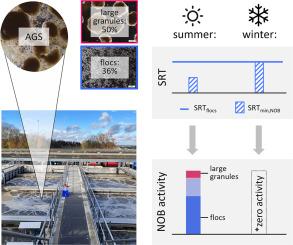The critical role of flocs in nitrification in full-scale aerobic granular sludge-based WWTP
IF 12.4
1区 环境科学与生态学
Q1 ENGINEERING, ENVIRONMENTAL
引用次数: 0
Abstract
Aerobic granular sludge (AGS) is usually considered to be a biofilm system consisting of granules only, although practical experience suggests that flocs and granules of various sizes co-exist. This study thus focused on understanding the contribution of flocs and granules of various sizes to nitrification in a full-scale AGS-based wastewater treatment plant (WWTP) operated as a sequencing batch reactor (SBR). The size distribution in terms of total suspended solids (TSS) and the distribution of the nitrifying communities and activities were monitored over 14 months. Our results indicate that AGS is a hybrid system in which flocs (<0.25 mm) play a critical role in nitrification. AGS consisted of 36 % flocs and 50 % large granules (>2 mm) at a TSS concentration of 4.7 ± 0.7 gTSS L-1. The growth of ammonia oxidizing bacteria (AOB) and nitrite oxidizing bacteria (NOB) in large granules was limited due to the high mass transfer limitation in biofilm and the high solids retention time (SRT) of flocs, where favorable conditions for the growth of nitrifiers were maintained during the warm season. The specific activities of the small aggregates (<1 mm) were 5 to 15 times higher than those of large granules. As a result, flocs contributed >50 % to nitrification during the warm season, whereas granules >1 mm contributed <20 %. Such predominance of flocs in nitrification became problematic in the cold season when the minimum SRT of NOB increased to values similar to the floc SRT, resulting in 79 % loss of the NOB. Consequently, NOB activities dropped, and elevated effluent nitrite concentrations of several mgN L-1 were monitored. We suggest operating AGS systems similarly to hybrid systems in order to promote the enrichment of NOB in the granules by controlling the floc SRT at low values smaller than the minimum SRT of NOB throughout the year.


絮凝体在全规模好氧颗粒污泥污水处理厂硝化中的关键作用
好氧颗粒污泥(AGS)通常被认为是一个仅由颗粒组成的生物膜系统,尽管实践经验表明,絮凝体和不同大小的颗粒并存。因此,本研究的重点是了解絮凝体和不同大小的颗粒在作为顺序间歇式反应器(SBR)运行的全规模ags废水处理厂(WWTP)中的硝化作用。监测了14个月的总悬浮物(TSS)大小分布、硝化群落分布和活性。研究结果表明,AGS是一个混合系统,其中絮凝体(<0.25 mm)在硝化过程中起关键作用。在TSS浓度为4.7±0.7 gTSS L-1的条件下,AGS由36%的絮凝体和50%的大颗粒(>2 mm)组成。氨氧化菌(AOB)和亚硝酸盐氧化菌(NOB)在大颗粒中的生长受到生物膜传质限制和絮凝体固相停留时间(SRT)的限制,而暖季则保持了硝化菌生长的有利条件。小颗粒(1 mm)的比活性是大颗粒的5 ~ 15倍。结果表明,在暖季,絮凝体对硝化作用的贡献率为50%,而1毫米颗粒对硝化作用的贡献率为20%。在寒冷季节,当NOB的最小SRT增加到与絮体SRT相似的值时,这种絮体在硝化中的优势就出现了问题,导致NOB损失79%。因此,NOB活性下降,并监测出水亚硝酸盐浓度升高数mgnl -1。我们建议使用与混合系统类似的AGS系统,通过将絮体SRT控制在低于全年NOB最小SRT的低值来促进颗粒中NOB的富集。
本文章由计算机程序翻译,如有差异,请以英文原文为准。
求助全文
约1分钟内获得全文
求助全文
来源期刊

Water Research
环境科学-工程:环境
CiteScore
20.80
自引率
9.40%
发文量
1307
审稿时长
38 days
期刊介绍:
Water Research, along with its open access companion journal Water Research X, serves as a platform for publishing original research papers covering various aspects of the science and technology related to the anthropogenic water cycle, water quality, and its management worldwide. The audience targeted by the journal comprises biologists, chemical engineers, chemists, civil engineers, environmental engineers, limnologists, and microbiologists. The scope of the journal include:
•Treatment processes for water and wastewaters (municipal, agricultural, industrial, and on-site treatment), including resource recovery and residuals management;
•Urban hydrology including sewer systems, stormwater management, and green infrastructure;
•Drinking water treatment and distribution;
•Potable and non-potable water reuse;
•Sanitation, public health, and risk assessment;
•Anaerobic digestion, solid and hazardous waste management, including source characterization and the effects and control of leachates and gaseous emissions;
•Contaminants (chemical, microbial, anthropogenic particles such as nanoparticles or microplastics) and related water quality sensing, monitoring, fate, and assessment;
•Anthropogenic impacts on inland, tidal, coastal and urban waters, focusing on surface and ground waters, and point and non-point sources of pollution;
•Environmental restoration, linked to surface water, groundwater and groundwater remediation;
•Analysis of the interfaces between sediments and water, and between water and atmosphere, focusing specifically on anthropogenic impacts;
•Mathematical modelling, systems analysis, machine learning, and beneficial use of big data related to the anthropogenic water cycle;
•Socio-economic, policy, and regulations studies.
 求助内容:
求助内容: 应助结果提醒方式:
应助结果提醒方式:


